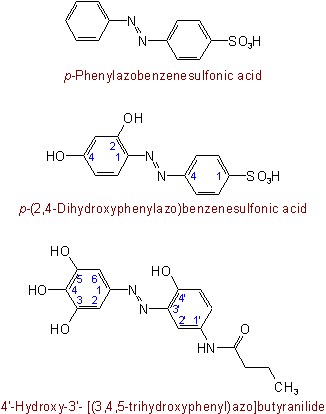
ACD/Name (Chemist Version) offers a standardized set of features for quick and simple generation of IUPAC names, and structures from names. It is a streamlined version of our popular ACD/Name software.
View a full description and pricing on our web store.

912.1 - As described in Rule C-911, but only in absence of a group that can be cited as a suffix, monoazo compounds RN=NR, in which the azo group -N=N- links radicals derived from parent molecules that, when unsubstituted, are identical, are named by adding the prefix "azo-" to the name of the unsubstituted parent molecule. Substituents are denoted in the usual way by prefixes and the shorter set (or, if of equal length, that with higher numbers) is distinguished by primes. The azo group has priority for lowest available numbers.
912.2 - When each group R in the azo compound RN=NR is (a) identical when unsubstituted and (b) carries the same number of the same group that is to be cited as suffix, then the azo compound is named as an assembly of identical units (see Subsection C-0.7). The name of the unsubstituted parent compound is preceded by a prefix "azodi-", and this is preceded by prefixes for the other substituents; the group to be cited as suffix is placed last. The suffix has a locant as low as possible and, if a choice remains, lower locants are next given to the azo links; the higher azo locant is primed, and so are the locants of any other substituents in the ring whose azo locant is primed.Example to Rule C-912.1
912.3 - For other monoazo compounds RN=NR, derived from parent molecules RH that, when unsubstituted, are identical, the molecule RH carrying the larger number of groups to be cited as suffix is chosen as parent and named as substituted by all the remaining groups; the group R in the substituting RN=N- group is named as a radicalExample to Rule C-912.2
912.4 - In the name of a monoazo compoundExamples to Rule C-912.3

(For numbering see Rule C-825.1)
 , where the azo group links groups which, when unsubstituted, are different, a parent molecule
, where the azo group links groups which, when unsubstituted, are different, a parent molecule  is treated as
substituted by a radical
is treated as
substituted by a radical  , that parent
, that parent  being chosen which has the larger number of the same group for citation as suffix; or, if the number in each is equal, the
more complex group is chosen for the parent molecule
being chosen which has the larger number of the same group for citation as suffix; or, if the number in each is equal, the
more complex group is chosen for the parent molecule  .
.
912.5 - Bisazo compounds and more complex analogues are named as follows: (a) as substituted derivatives of a parent chosen according to the principles of Rule C-912.4; or (b), when the terminal units are derived from identical molecules and when these units carry the greater number of the groups having priority for citation as suffix, then the whole may be named as an assembly of identical units (see Rule C-912.2).Examples to Rule C-912.4
See Recommendations'93 R-5.3.3Examples to Rule C-912.5


Published with permission of the IUPAC by Advanced Chemistry Development, Inc., www.acdlabs.com, +1(416)368-3435 tel, +1(416)368-5596 fax. For comments or suggestions please contact [email protected]